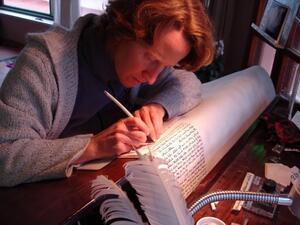First Torah commissioned to be scribed entirely by women is read in Seattle
Courtesy of the Women's Torah Project
On October 16, 2010, the Kadima Reconstructionist Jewish Community in Seattle read from the first Torah ever commissioned to be written by a group of women. In 2000, members of Kadima, who had used borrowed Torahs for 25 years, set out to purchase one of their own. A rabbi in the congregation suggested that Kadima take a bold step: commission women — and only women — to create a scroll for the community. Thus began what came to be called the Women’s Torah Project.
The Talmud (Gittin 45b) explicitly states that a Torah, mezuzah, or teffilin written by a woman (or anyone else who does not lay teffilin) are illegitimate. However, the Arba'ah Turim (often simply called the Tur), another halakhic source, does not include women among those unqualified to serve as soferim (scribes). The Women’s Torah Project paid close attention to halakha and capitalized on Tur as a legal source.
As more money was raised, more women were trained as soferot. Jewish women artists were also recruited to create the other ornamental pieces integral to a Torah—the yad, mantle, breastplate, crowns, and wimple clasp.
Wendy Graff, director of the Women’s Torah Project, got involved during her daughter’s bat mitzvah. “I thought to myself, if my daughter could read and study the Torah and yet not be allowed to create the scroll that is the basis of our faith, then we still have a long way to go.” The efforts of the Women’s Torah Project have helped build momentum for the change.
Since it began, other congregations and Jewish organizations have taken a more positive view of soferot. In 2007, Jen Taylor Friedman of Great Britain became the first woman to complete the scribing of a Torah, which now has a home in the United Hebrew Congregation of St. Louis. Currently, Julie Seltzer, who also worked on the Women’s Torah Project, is scribing a Torah for the Contemporary Jewish Museum in San Francisco.
Many of the new Torah’s scribes and artists — all Jewish women — were in attendance when Kadima celebrated its completion on October 13-16, 2010, at the University of Washington Hillel House.
Read more: “As New Year Dawns, Jewish Women Mark Milestones,” the Jewish Daily Forward.
Sources: Kadima Reconstructionist Jewish Community; Women’s Torah Project.




Rabbi Linda Motzkin, of Temple Sinai of Saratoga Springs, New York, and author of the "Aleph Isn't Tough" series of Hebrew for Adults books, is also scribing a Torah for her congregation (it may be done by now, I don't know). What is fascinating about her project is that, as most establishments that supply scribes with ink and parchment are Orthodox owned, she had difficulty obtaining writing materials. So, Rabbi Motzkin learned the art of kosher parchment making! This also enabled her to involve the wider community in the project, as deer hides were donated by local non-Jewish hunters (deer is a kosher animal; for the parchment to be kosher, the animal must be kosher but does not have to be kosher slaughtered; the preparation of the hides, however, must follow Halachah). She also makes her own quills, and has experimented with making her own ink. Her teacher relied on her status as a Rabbi to justify her being able to scribe a kosher Torah, as Halachah allows (if I am not mistaken - I'm no expert) a kosher Torah to be scribed by a leader of the community who has been entrusted to do so.